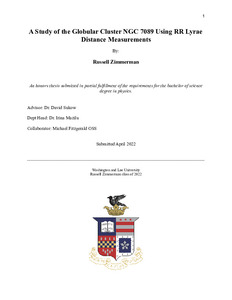A Study of the Globular Cluster NGC 7089 Using RR Lyrae Distance Measurements (thesis)

View/
Author
Zimmerman, Russell Lee
Subject
Washington and Lee University -- Honors in Physics
RR Lyrae stars
Stars -- Globular clusters
Metadata
Show full item recordDescription
Thesis; [FULL-TEXT FREELY AVAILABLE ONLINE] Russell Lee Zimmerman is a member of the Class of 2022 of Washington and Lee University. Globular clusters are gravitationally bound groups of stars averaging about 13 billion years old. Since the universe itself is around 14 billion years old, globular clusters can give valuable insight into the formation history of galaxies. A significant percentage of the stars making up globular clusters are RR Lyrae variable stars. These stars' pulsation periods are measured in order to determine the star's distance to Earth. In this study 14 RR Lyrae variable stars from globular cluster NGC 7089 (M2) are measured using 1 meter Sinistro telescopes accessed through Las Cumbres Observatory's network of robotic telescopes. From these measurements a distance estimate of NGC 7089 to earth is found to be 11.48kpc. I also provide evidence that NGC 7089 is an Oosterhoff II cluster through examination of average RRab pulsation period, r value, metallicity, and age of the cluster. Russell Zimmerman